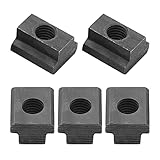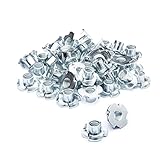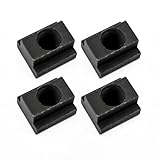How to Install T-Nuts
Mark t-nut locations. Clamp several plywood sheets together. T-nut holes are spaced every 8". Start the pattern 4" from the edge. Stack the sheets of plywood and drill t-nut holes for three or four sheets at a time. This will save you time... Using a pencil and straight edge or chalk line, mark parallel lines on the sheet 8" apart. Start this pattern 4" from the edge as shown. Using a 7/16" bit, drill through both pieces of plywood. This grid spacing will give you 72 t-nut holes spaced equally without hitting a 2x4 and will give you the flexibility to space the 2x4 supports at either 24" or 16" spacing.
 Drilling T-Nut Holes
Drilling T-Nut HolesDrill T-nut Holes. It is much easier to drill these holes on a set of saw horses than when the climbing wall is already put up. Place two sheets of plywood together and face up on saw horses or some construction bench. The sheets should be face up (climbing side up) when you drill the holes. It may or may not matter to you which side of sheathing you climb on. But if it does, make sure you drill from the "climbing side". This will cause the splinters from drilling the holes to be on the other side.
 Preparing to Install-T-Nuts for a Climbing Wall
Preparing to Install-T-Nuts for a Climbing WallWhen to install t-nuts. Install t-nuts after the plywood wall panel sections are cut out and before they are installed on the frame. The reason not to install t-nuts after the plywood is mounted on the frame is because it is much more difficult to pound them in upward or at an angle and secondly the pounding on the wall isn't good for the joints in the frame, and the frame will absorb the force making it more difficult to seat the t-nut. The reason not to install t-nuts before cutting the plywood shapes is because the locations of the t-nuts may fall along a cut line and you will have to pull it out before cutting. Furthermore there are many leftover scrap pieces after cutting the plywood shapes so many t-nuts would be on the scrap pieces.
Installing t-nuts. Lay the plywood panels face down (the climbing surface down). Install the t-nuts from the opposite side that you drilled the holes. Use a hammer to get the t-nuts completely flush and seated. Make sure they are straight and flush with the surface of the plywood. There are 288 in one 4x8 sheet of plywood. Your arm will bet tired but stick with it and get them all seated correctly. It is much more difficult to correct a poorly seated t-nut than to get it right the first time.
 Correctly Seated T-nuts
Correctly Seated T-nutsHold the t-nut and start it into the hole. Once it is started, a couple of solid and square hammer hits will be enough to seat it. The head of the t-nut should be completely flat and flush with the plywood. Be careful not to hit off center. An off-center hit will make the t-nut press into the hole at an angle. If this happens pull it out with the claw of your hammer and try again. t-nuts that are not squared up with the wood will be very difficult to thread a bolt into. When you install a hold, The bolt goes through the hold then into the t-nut therefor you can’t align the bolt to the angle of the T-nut in order to get the threads started.
Make sure you seat the T-nut square with the plywood panel. If a t-nut isn't seated squarely the back surface of the hold won’t sit flush with the plywood panel. This condition will cause a spinner. If it doesn't get hammered in straight the best thing to do is pull it out and try again.
Make a T-Nut Installer. Here's a way to tighten the t-nut using a drill and a 3/8" threaded rod. This method isn't faster than an hammer. This method is used for fixing spinning t-nuts. You only need a few things.
Purchase a 3/8 inch threaded rod, two nuts and two washers. Price 3/8 inch threaded rods on Amazon. Tighten two nuts against each other on the threaded rod. Tightening them against each other prevents them from traveling on the threads. Use washers to press against the nuts and climbing surface. For textured walls, add a block of wood so the washers do not damage the texture.
 T-Nut Installer
T-Nut InstallerInsert the threaded rod into the drill and clamp it directly with the drill's chuck. Then, insert the threaded rod through the t-nut hole and turn it until the threads catch. Use a slow speed on your drill. Tighten the T-nut against the back of the panel until until it is tight, then just reverse the drill to remove the threaded rod. This method works good if you need to tighten t-nuts that have loosened, or if your t-nuts weren't pounded in flush, or for replacing a spinning t-nut.
How to Replace a Spinning t-nut. Before you climb behind the wall stick something through the hole of the t-nut. Once you are behind the wall, you will be able to quickly locate it among the other t-nuts.
Usually a t-nut will spin because the teeth on the t-nut have bent due to a twisting force from a spinning hold. This probably gouged the plywood too. You can attempt to repair the wood with some wood glue in the hole, then put the t-nut back in the hole using a wood block. When the t-nut is in place use the t-nut installer method above to screw it tight. Leave it alone for a few hours while the wood glue dries.
If the plywood is damaged beyond repair the best thing to do is just abandon it and drill another hole. Mount a new T-nut using the process described above. Don't use a hammer to pound in the t-nut. Using a hammer to pound in T-nuts stress to the joints.
How to Build Your Own Climbing Wall Book. You'll find good tips like this in this book. It's a small investment compared to the cost of your wall. It has lots of pictures and much more information to make your project a success.












